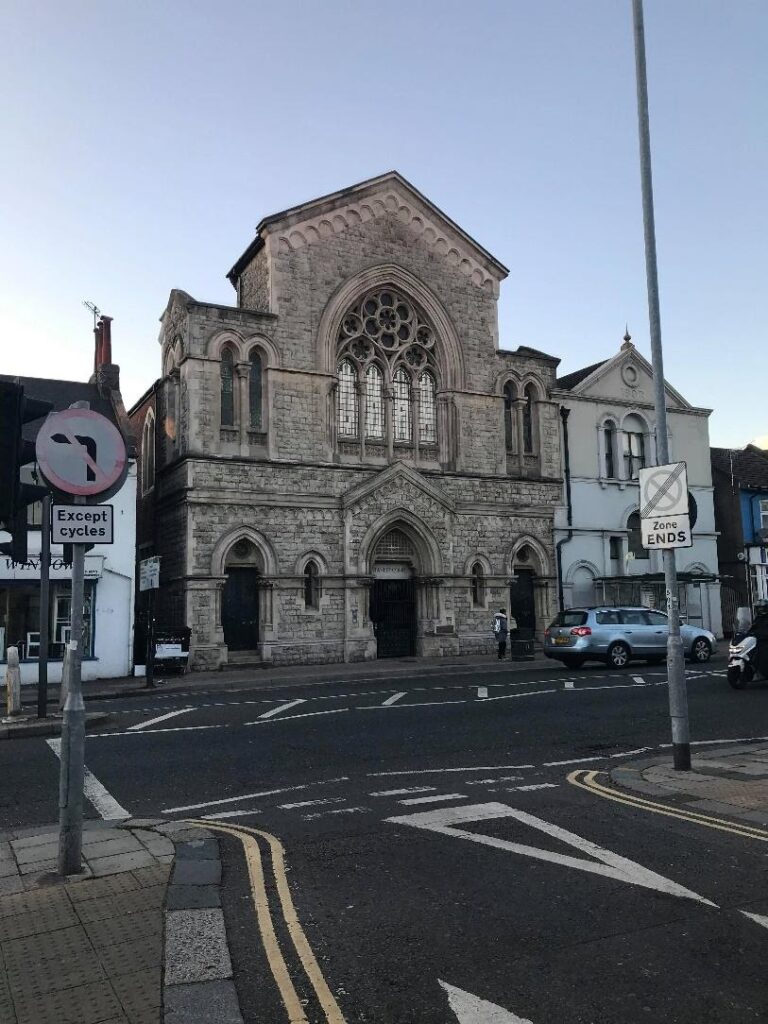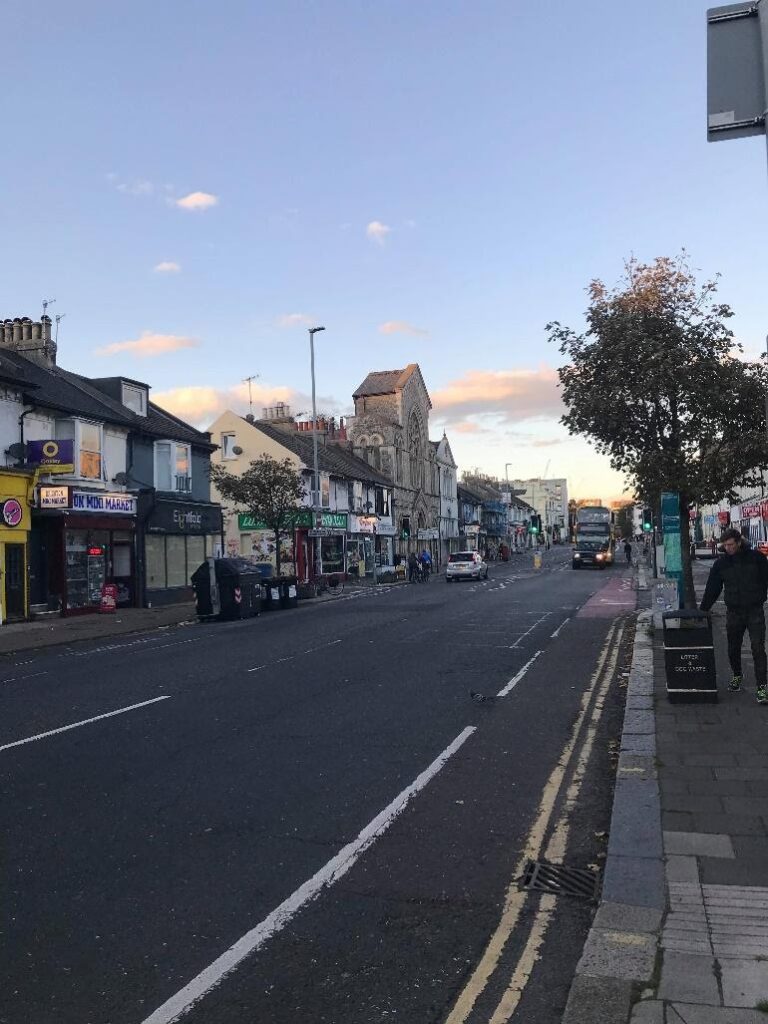Words and photos by Hal Keelin
On London Road, next to Empire tandoori and vision Windows, and opposite Bedzz Are Us and Pizza Hut, stands a peculiar, and seemingly far older establishment. At first glance it’s quite clearly a forgotten church. Yet, with its faded stone façade and long-since locked gate, it’s impenetrable and vacant looking. It’s incredibly hard to imagine it being used and seems like one of those buildings’ in a video game that your character can’t enter; all there is a façade. It’s as if it is only two dimensional.
It was once a place of depth and of function nevertheless. But who’s building was this, who came here and what does it tell us about the city ?
A little bit of internet digging reveals it once held the un-inspirational title of Lewes Road Congregational Church. This congregation started out in a school room on Lewes road, beginning their first meeting in January 1868. The building was completed on the 30th September 1879, with the school room being enlarged and a new church hall opening in 1909.
Albert Foyster held the job of first minister. He had ten children and unfortunately shares his name with a Nazi German politician, member of the SS and convicted war criminal. The Brightonian Foyster was far less sinister however and seems to have run the Lewes Road ministry without incident until his death in 1898.

The building itself is made of Kentish ragstone and it gets its imposing, almost haunted look from its Italian Gothic architectural style. Yet, as its without the magnificent domes of much more fabled ecclesiastical structures built in this style (take the Florence Cathedral for example) the Lewes Road construction is far less impressive and must have always looked a little out of place on the ever busy, chaotic route into the centre of Brighton.
There is a haunting image online from sometime in the 1930s with the congregation believed to be celebrating Empire Day. Empire Day was also known as Victoria Day and a vestige of it remains today in Commonwealth Day. The former was a patriotic holiday that first took place in 1902 to celebrate the late Queen’s birthday. In the creepy photo the church pastor appears at the centre, with the front rows made up of solemn looking children all sitting cross legged on the floor: the girls have bouquets while the boys have tin drums in their laps. Their parents very seriously stare back, behind, and standing above. Before the pastor is a woman, dressed and posing in what can only be an attempt to be Queen Victoria for she carries a sceptre and a large union jack.
Empire Day was a huge event for several decades, and was celebrated enthusiastically in Britain and its dominions, from Canada to New Zealand. These kinds of patriotic holidays were a key part to Britain’s identity and national image in the early part of the century and they too formed part of the nation and the empires childrens’ formal education. As Historic UK reveals, these kids were reminded that “the strength of the empire depended on them, and that they must never forget it”: children would walk, parade and sing patriotic songs such as the national anthem and Jerusalem. Inspirational voices spoke on platforms in towns across the world and it remained a key part of the nation’s calendar for half a century. There was even a rhyme to go with it: “remember, remember Empire Day, the 24th May”. It’s not quite as catchy as its Gunpowder plot cousin, is it.
In 1997 the church was bought by the YMCA; the Brighton branch of which was founded in 1872 and ran its operations from another peculiar building, Steine House, a walk towards the seafront from the congregational church.
The YMCA have since had the building converted to house Brighton’s homeless while the congregation moved to the far uglier new build on Saunders park rise.
From the Lewes Road Inn, to The Franklin Tavern, to The Franklin Arms and back to the Lewes Road Inn
A little further down and on the opposite side to the old Lewes Road Congregational Church, you’ll find the shiny, revamped Lewes Road Inn. Today the pub does an enticing range of homemade pizzas and intriguing student drink deals. The latest version of the pub – it has previously been known as The Franklin Tavern and then the Franklin Arms- is a throwback to when the establishment first started out as The Lewes Road Inn many moons ago. This Lewes Road Inn was tragically blown to pieces in the Second World War. On Friday 20th September 1940, it fell victim to a sudden German air raid and there were a series of casualties including a window cleaner killed as he passed on his bike. Ernest and Rosina the pub landlords were sadly buried under rubble and desperate volunteers and fire services were unable to get to them in time. Thankfully some survived: including the Barmaid after a four-hour ordeal, as well as Scully the Ernest and Rosie’s beloved terrier.
From Horse Stables to The Peoples Picture Palace, to The Arcadia Cinema, to Brighton Trades and Labour Club
16 Lewes road has too seen plenty of change over the years. It began with barely a year gone in the fast moving 20th century, as the site of Tilley’s horse bus stables beget victim to the shiny new tram network taking Lewes road by storm in 1901. They struggled on, but alas the horses could not keep pace and in 1907 the Tilley’s horse stables were let out to a fairground and animator picture house operator who showed films and variety acts.
Harry Houdini performed and probably walked out the back of St Martins with his entourage, up Park Crescent and through the main entrance which is now at the back of the building. But even as great acts and names as Houdini couldn’t keep the place going for long and it seems the venue switched to accommodate showing films as its permanent source of revenue.
A near 500-seater cinema opened on the site in 1910 as the short lived rendition of the site as The People’s Pleasure Palace became The Arcadia, where it seems to have enjoyed much more successful years. The owners were keen experimenters though and the buildings constant reimagining continued. Early experiments with three-dimensional imaging or stereoscopic projection systems came in at the beginning of the Great War, and a few stage productions appeared. After many successful years The Arcadia sadly showed its last films The Duchess of Idaho and The Big Hangover (a peculiar film about a man developing “liquor recoil” after falling into a vat of brandy) on May 26th, 1956.



[…] What’s on our streets Week 1: Lewes Road — The Badger […]